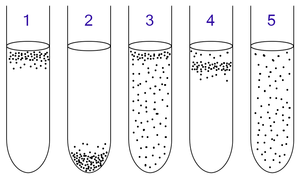Anaerobic organism

1: Obligate aerobic bacteria gather at the top of the test tube in order to absorb maximal amount of oxygen.
2: Obligate anaerobic bacteria gather at the bottom to avoid oxygen.
3: Facultative bacteria gather mostly at the top, since aerobic respiration ist the most beneficial one; but as lack of oxygen does not hurt them, they can be found all along the test tube.
4: Microaerophiles gather at the upper part of the test tube but not at the top. They require oxygen but at a low concentration.
5: Aerotolerant bacteria are not affected at all by oxygen, and they are evenly spread along the test tube.
An anaerobic organism is any organism that does not require oxygen for growth.
- Obligate anaerobes will die when exposed to atmospheric levels of oxygen.
- Facultative anaerobes can use oxygen when it is present.
- Aerotolerant organisms can survive in the presence of oxygen, but they are anaerobic because they do not use oxygen as a terminal electron acceptor.
Microaerophiles are organisms that may use oxygen, but only at low concentrations (low micromolar range); their growth is inhibited by normal oxygen concentrations (approximately 200 micromolar). Nanaerobes are organisms that cannot grow in the presence of micromolar concentrations of oxygen, but can grow with and benefit from nanomolar concentrations of oxygen.
Obligate anaerobes may use fermentation or anaerobic respiration. In the presence of oxygen, facultative anaerobes use aerobic respiration; without oxygen some of them ferment, some use anaerobic respiration. Aerotolerant organisms are strictly fermentative. Microaerophiles carry out aerobic respiration, and some of them can also do anaerobic respiration.
There are many chemical equations for anaerobic fermentative reactions.
Fermentative anaerobic organisms mostly use the lactic acid fermentation pathway:
- C6H12O6 + 2 ADP + 2 phosphate → 2 lactic acid + 2 ATP
The energy released in this equation is approximately 150 kJ per mol, which is conserved in regenerating two ATP from ADP per glucose. This is only 5% of the energy per sugar molecule that the typical aerobic reaction generates.
Plants and fungi (e.g., yeasts) generally use alcohol (ethanol) fermentation when oxygen becomes limiting:
- C6H12O6 + 2 ADP + 2 phosphate → 2 C2H5OH + 2 CO2 + 2 ATP
The energy released is about 180 kJ per mol, which is conserved in regenerating two ATP from ADP per glucose.
Anaerobic bacteria and archaea use these and many other fermentative pathways, e.g., propionic acid fermentation, butyric acid fermentation, solvent fermentation, mixed acid fermentation, butanediol fermentation, Stickland fermentation, acetogenesis or methanogenesis.
Some anaerobic bacteria produce toxins (e.g., tetanus or botulinum toxins) that are highly dangerous to higher organisms, including humans.
Obligate (strict) anaerobes die in presence of oxygen due to the absence of the enzymes superoxide dismutase and catalase which would convert the lethal superoxide formed in their cells due to the presence of oxygen.
